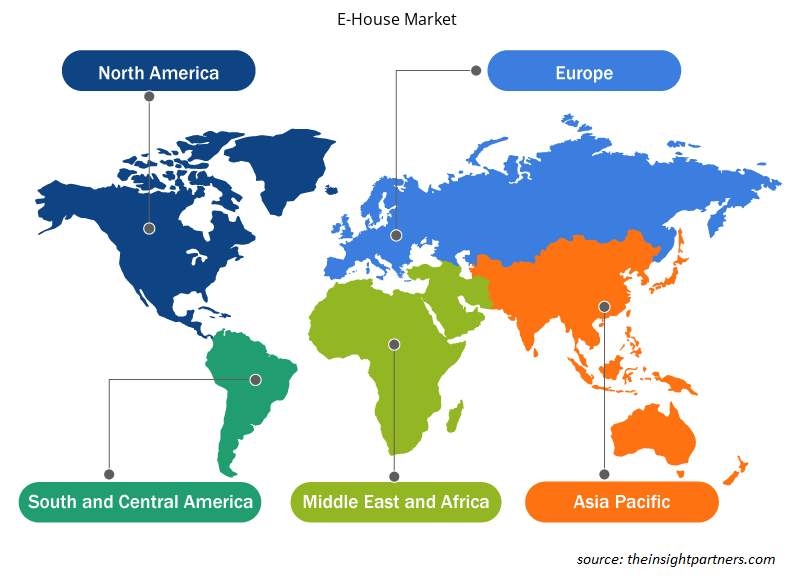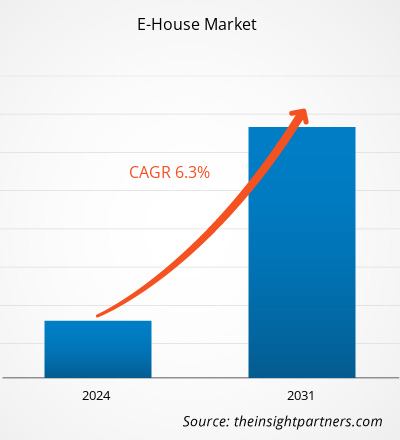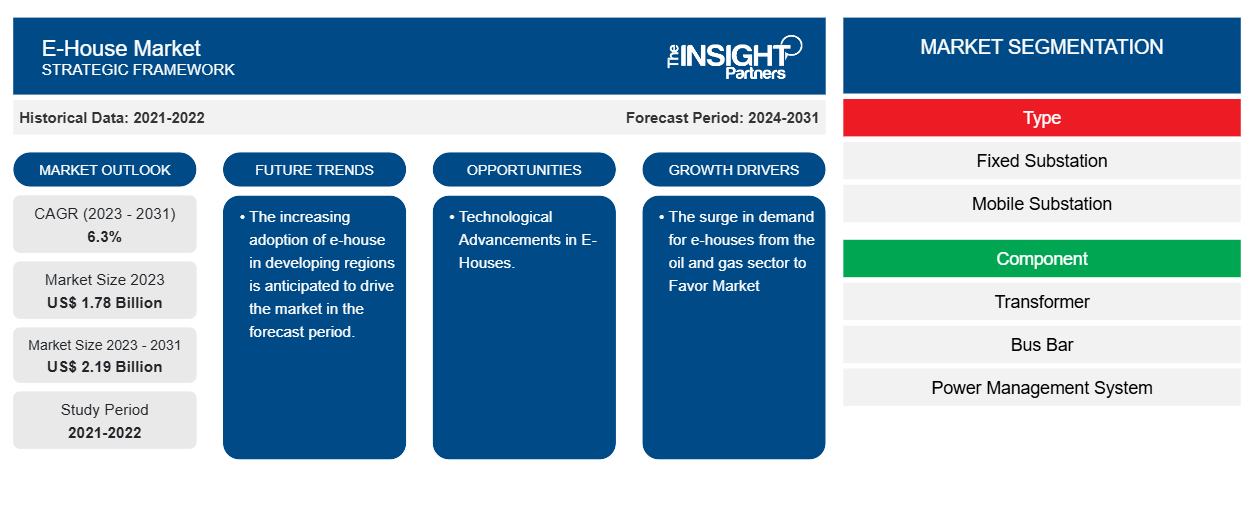Der E-House-Markt soll von 1,78 Milliarden US-Dollar im Jahr 2023 auf 2,91 Milliarden US-Dollar im Jahr 2031 anwachsen. Der Markt soll zwischen 2023 und 2031 eine durchschnittliche jährliche Wachstumsrate von 6,3 % verzeichnen. Die einfache Installation, Kosteneffizienz und Flexibilität des E-House sowie die steigende Nachfrage nach E-Houses aus dem Öl- und Gassektor dürften die wichtigsten Treiber und Trends des E-House-Marktes sein.CAGR of 6.3% during 2023–2031. The ease of installation, cost-effectiveness, and flexibility of the E-House and the surge in demand for
E-House-Marktanalyse
Der E-House-Markt verzeichnet weltweit ein deutliches Wachstum. Dieses Wachstum ist auf die einfache Installation, Kosteneffizienz und Flexibilität von E-Houses sowie auf die steigende Nachfrage nach E-Houses aus dem Öl- und Gassektor zurückzuführen. Darüber hinaus wird erwartet, dass die Einführung von E-Houses in Entwicklungsregionen und der technologische Fortschritt in den kommenden Jahren zahlreiche Chancen mit sich bringen werden.
E-House Marktübersicht
E-Houses sind vorgefertigte Umspannwerke, die als Stromverteilungszentren eingesetzt werden. Solche Container-Umspannwerke bieten bei Bedarf Schalträume. Für spezielle Anwendungen wie Rechenzentren können Skids für eine schnelle Bereitstellung bereitgestellt werden. Mobile E-Houses werden als tragbare Umspannwerke auf Anhängern installiert.switchgear rooms as required. For special applications like Datacenters skids can be provided for rapid deployment. Mobile E-Houses are installed on trailers as portable substations.
Passen Sie diesen Bericht Ihren Anforderungen an
Sie erhalten kostenlos individuelle Anpassungen an jedem Bericht, einschließlich Teilen dieses Berichts oder einer Analyse auf Länderebene, eines Excel-Datenpakets sowie tolle Angebote und Rabatte für Start-ups und Universitäten.
-
Holen Sie sich die wichtigsten Markttrends aus diesem Bericht.Dieses KOSTENLOSE Beispiel umfasst eine Datenanalyse von Markttrends bis hin zu Schätzungen und Prognosen.
Treiber und Chancen des E-House-Marktes
Die stark gestiegene Nachfrage nach E-Häusern aus dem Öl- und Gassektor begünstigt den Markt.
Mobile E-Houses werden als tragbare Umspannwerke auf Anhängern installiert. Alle E-House-Typen können verschiedene Projektherausforderungen lösen und gemeinsame Nachhaltigkeitsziele unterstützen. E-Houses werden in Upstream-, Midstream- und Downstream-Öl- und Gasanlagen eingesetzt. Sie beherbergen Geräte zur Stromverteilung, Steuerungssysteme und Instrumente, die für die Förderung, Verarbeitung und den Transport von Öl und Gas von entscheidender Bedeutung sind. E-Houses werden häufig in der Öl- und Gas- und Bergbauindustrie und immer häufiger für die Installation von Geräten in anderen Sektoren eingesetzt. Unter Berücksichtigung der oben genannten Parameter treibt der Anstieg der Nachfrage nach E-Houses aus dem Öl- und Gassektor den Markt an.
Technologische Fortschritte in E-Häusern.
Der technologische Fortschritt bei den E-Houses wird den Markt in den kommenden Jahren voraussichtlich antreiben. Der Markt hat in den letzten Jahren bedeutende technologische Fortschritte erlebt. Diese Fortschritte werden durch den Bedarf an effizienteren, zuverlässigeren und anpassungsfähigeren Energielösungen in einer Vielzahl von Sektoren vorangetrieben. Verschiedene Unternehmen bieten technologisch fortschrittliche E-House-Lösungen an. Kontrolmatik beispielsweise bleibt bei den technologischen Fortschritten im E-House-Design an der Spitze. Das Unternehmen integriert die neuesten intelligenten Technologien, energieeffizienten Lösungen und fortschrittlichen Steuerungssysteme, um seinen Kunden hochmoderne Lösungen zu bieten. Daher wird erwartet, dass die technologischen Fortschritte bei den E-Houses das Marktwachstum in den kommenden Jahren vorantreiben werden.Kontrolmatik stays at the forefront of technological advancements in E-House design. The company integrates the latest smart technologies, energy-efficient solutions, and advanced control systems to provide cutting-edge solutions to its clients. Thus, the technology advancements in the e-houses are anticipated to drive market growth in the coming years.
Segmentierungsanalyse des E-House-Marktberichts
Schlüsselsegmente, die zur Ableitung der E-House-Marktanalyse beigetragen haben, sind Typ, Komponente und Anwendungen.
- Der E-House-Markt ist nach Typ in feste und mobile Umspannwerke unterteilt. Das Segment der festen Umspannwerke dürfte im Prognosezeitraum einen erheblichen Marktanteil halten.
- Basierend auf den Komponenten ist der E-House-Markt in Transformatoren, Sammelschienen, Energiemanagementsysteme, Frequenzumrichter, Schaltanlagen, HVAC und andere unterteilt. Es wird erwartet, dass das Transformatorsegment im Prognosezeitraum einen erheblichen Marktanteil halten wird.switchgear, HVAC, and others. The transformer segment is anticipated to hold a significant market share in the forecast period.
- Nach Anwendung ist der Markt in Industrie und Versorgungsunternehmen unterteilt. Die Versorgungsunternehmen werden im Prognosezeitraum voraussichtlich einen erheblichen Marktanteil halten.
E-House-Marktanteilsanalyse nach Geografie
Der geografische Umfang des E-House-Marktberichts ist hauptsächlich in fünf Regionen unterteilt: Nordamerika, Asien-Pazifik, Europa, Naher Osten und Afrika sowie Süd- und Mittelamerika.
Nordamerika dominiert den E-House-Markt. Der nordamerikanische Markt ist in die USA, Kanada und Mexiko unterteilt. Der Trend zur Einführung hochtechnologischer Technologien in verschiedenen Branchen in der nordamerikanischen Region hat das Wachstum des E-House-Marktes vorangetrieben. Faktoren wie die zunehmende Einführung digitaler Tools und hohe Technologieausgaben von Regierungsbehörden dürften das Wachstum des nordamerikanischen E-House-Marktes vorantreiben. Darüber hinaus zwingt eine starke Betonung von Forschung und Entwicklung in den entwickelten Volkswirtschaften der USA und Kanadas die nordamerikanischen Akteure dazu, technologisch fortschrittliche Lösungen auf den Markt zu bringen. Darüber hinaus gibt es in den USA eine große Anzahl von E-House-Marktakteuren, die sich zunehmend auf die Entwicklung innovativer Lösungen konzentrieren. All diese Faktoren tragen zum Wachstum des E-House-Marktes in der Region bei.fuelled the growth of the e-house market. Factors such as increased adoption of digital tools and high technological spending by government agencies are expected to drive the North American e-house market growth. Moreover, a strong emphasis on research and development in the developed economies of the US and Canada is forcing the North American players to bring technologically advanced solutions into the market. In addition, the US has a large number of e-house market players who have been increasingly focusing on developing innovative solutions. All these factors contribute to the region's growth of the e-house market.
Regionale Einblicke in den E-House-Markt
Die regionalen Trends und Faktoren, die den E-House-Markt im Prognosezeitraum beeinflussen, wurden von den Analysten von Insight Partners ausführlich erläutert. In diesem Abschnitt werden auch E-House-Marktsegmente und -Geografie in Nordamerika, Europa, im asiatisch-pazifischen Raum, im Nahen Osten und Afrika sowie in Süd- und Mittelamerika erörtert.

- Holen Sie sich die regionalspezifischen Daten für den E-House-Markt
Umfang des E-House-Marktberichts
| Berichtsattribut | Details |
|---|---|
| Marktgröße im Jahr 2023 | 1,78 Milliarden US-Dollar |
| Marktgröße bis 2031 | 2,19 Milliarden US-Dollar |
| Globale CAGR (2023 - 2031) | 6,3 % |
| Historische Daten | 2021-2022 |
| Prognosezeitraum | 2024–2031 |
| Abgedeckte Segmente |
Nach Typ
|
| Abgedeckte Regionen und Länder |
Nordamerika
|
| Marktführer und wichtige Unternehmensprofile |
|
Dichte der E-House-Marktteilnehmer: Deren Auswirkungen auf die Geschäftsdynamik verstehen
Der E-House-Markt wächst rasant, angetrieben durch die steigende Nachfrage der Endnutzer aufgrund von Faktoren wie sich entwickelnden Verbraucherpräferenzen, technologischen Fortschritten und einem größeren Bewusstsein für die Vorteile des Produkts. Mit steigender Nachfrage erweitern Unternehmen ihr Angebot, entwickeln Innovationen, um die Bedürfnisse der Verbraucher zu erfüllen, und nutzen neue Trends, was das Marktwachstum weiter ankurbelt.
Die Marktteilnehmerdichte bezieht sich auf die Verteilung der Firmen oder Unternehmen, die in einem bestimmten Markt oder einer bestimmten Branche tätig sind. Sie gibt an, wie viele Wettbewerber (Marktteilnehmer) in einem bestimmten Marktraum im Verhältnis zu seiner Größe oder seinem gesamten Marktwert präsent sind.
Die wichtigsten auf dem E-House-Markt tätigen Unternehmen sind:
- ABB Ltd
- Eaton
- Becker Mining Systems AG
- Schneider Electric SE
- Siemens AG
- WEG
Haftungsausschluss : Die oben aufgeführten Unternehmen sind nicht in einer bestimmten Reihenfolge aufgeführt.

- Überblick über die wichtigsten Akteure auf dem E-House-Markt
E-House-Marktnachrichten und aktuelle Entwicklungen
Der E-House-Markt wird durch die Erhebung qualitativer und quantitativer Daten nach Primär- und Sekundärforschung bewertet, die wichtige Unternehmenspublikationen, Verbandsdaten und Datenbanken umfasst. Nachfolgend sind einige der Entwicklungen auf dem E-House-Markt aufgeführt:
- Hartek Power hat sich mit TP Western Odisha Distribution Limited (TPWODL), einem Joint Venture von TATA Power und Odisha Distribution Limited, für einen Auftrag über zwei neue schlüsselfertige 33/11-kV-Umspannwerke im E-House-Containerformat im Wert von 2,99 Millionen US-Dollar zusammengeschlossen. (Quelle: Hartek Power Company Website, August 2023)
Abdeckung und Ergebnisse des E-House-Marktberichts
Der Bericht „E-House-Marktgröße und -Prognose (2021–2031)“ bietet eine detaillierte Analyse des Marktes, die die folgenden Bereiche abdeckt:
- E-House-Marktgröße und -Prognose auf globaler, regionaler und Länderebene für alle wichtigen Marktsegmente, die im Rahmen des Berichts abgedeckt sind
- E-House-Markttrends sowie Marktdynamik wie Treiber, Beschränkungen und wichtige Chancen
- Detaillierte PEST/Porters Five Forces- und SWOT-Analyse
- E-House-Marktanalyse mit wichtigen Markttrends, globalen und regionalen Rahmenbedingungen, wichtigen Akteuren, Vorschriften und aktuellen Marktentwicklungen
- Branchenlandschaft und Wettbewerbsanalyse, einschließlich Marktkonzentration, Heatmap-Analyse, prominenten Akteuren und aktuellen Entwicklungen im E-House-Markt.
- Detaillierte Firmenprofile
- Historische Analyse (2 Jahre), Basisjahr, Prognose (7 Jahre) mit CAGR
- PEST- und SWOT-Analyse
- Marktgröße Wert/Volumen – Global, Regional, Land
- Branchen- und Wettbewerbslandschaft
- Excel-Datensatz
Aktuelle Berichte
Erfahrungsberichte
Grund zum Kauf
- Fundierte Entscheidungsfindung
- Marktdynamik verstehen
- Wettbewerbsanalyse
- Kundeneinblicke
- Marktprognosen
- Risikominimierung
- Strategische Planung
- Investitionsbegründung
- Identifizierung neuer Märkte
- Verbesserung von Marketingstrategien
- Steigerung der Betriebseffizienz
- Anpassung an regulatorische Trends























 Kostenlose Probe anfordern für - E-House-Markt
Kostenlose Probe anfordern für - E-House-Markt